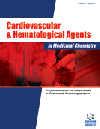- Home
- A-Z Publications
- Cardiovascular & Hematological Agents in Medicinal Chemistry (Formerly Current Medicinal Chemistry - Cardiovascular & Hematological Agents)
- Previous Issues
- Volume 5, Issue 2, 2007
Cardiovascular & Hematological Agents in Medicinal Chemistry (Formerly Current Medicinal Chemistry - Cardiovascular & Hematological Agents) - Volume 5, Issue 2, 2007
Volume 5, Issue 2, 2007
-
-
Sclerosing Polidocanol Injections of Small Vessels to Treat the Chronic Painful Tendon
More LessAuthors: H. Alfredson and R. LorentzonThe chronic painful tendon (tendinopathy, tendinosis) is generally considered difficult to treat, not seldom causing long-term disability and sometimes ending the sports or work carreer. Most common sites for tendinopathy are the Achilles-, patellar-, extensor carpi radialis brevis (ERCB)-, and supraspinatus tendons. The origin of pain has for many years been unknown, but recently, by using ultrasound (US) + colo Read More
-
-
-
Relaxin as a Cardiovascular Hormone: Physiology, Pathophysiology and Therapeutic Promises
More LessAuthors: Silvia Nistri, Mario Bigazzi and Daniele BaniRelaxin is a hormone belonging to the so-called relaxin superfamily, which also includes insulin-like peptides. Relaxin is best known for its effects on the female reproductive system, which primarily include lengthening of the pubic symphysis and softening of the tissues of the birth canal, stimulating mammary and endometrial development, and maintenance of myometrial quiescence. In recent years, evidence has been a Read More
-
-
-
Integrins: Novel Therapeutic Targets for Cardiovascular Diseases
More LessIntegrins are the principle mediators of molecular dialog between a cell and its extracellular matrix environment. The unique combinations of integrin subunits determine which extracellular matrix molecules are recognized by a cell. Recent studies have demonstrated that remodeling in heart and vasculature is linked to alterations in extracellular matrix and integrin expression. The roles of integrins in controlling cellular b Read More
-
-
-
Emerging Therapeutic Approaches Multi-Targeting Receptor Tyrosine Kinases and G Protein-Coupled Receptors in Cardiovascular Disease
More LessAuthors: C. Flordellis, P. Papathanasopoulos, A. Lymperopoulos, J. Matsoukas and H. ParisAdvances in molecular biology and functional genomics have demonstrated that the “one gene-one phenotypeone drug” paradigm, that has dominated pharmaceutical industry and clinical pharmacology thinking, is too simplistic for management of complex polygenic traits. The traditional highly specific drugs with unique target have proven their clinical usefulness. However, they do not always display the require Read More
-
-
-
Current and Emerging Concepts in the Management of Neovascular Age-Related Macular Degeneration
More LessAuthors: S. C. Maloney, K. D. Godeiro, A. N. Odashiro and M. N. BurnierAge-related macular degeneration (AMD) is the leading cause of blindness in the elderly worldwide. The more severe form of the disease, known as neovascular AMD, is characterized by aberrant growth of blood vessels from the choroid into the subretinal space. This pathologic choroidal neovascularization can have drastic consequences, often seriously impairing vision in affected individuals. Current treatment approache Read More
-
-
-
Nitric Oxide, Malnutrition and Chronic Renal Failure
More LessThe conditionally essential amino acid L-arginine is the substrate for nitric oxide (NO) synthesis, a key second messenger involved in physiological functions including endothelium-dependent vascular relaxation and inhibition of platelet adhesion and aggregation. Extracellular L-arginine transport seems to be essential for the production of NO by the action of NO synthases (NOS), even when the intracellular levels of L-ar Read More
-
-
-
Molecular Genetics of Quantitative Fibrinogen Disorders
More LessAuthors: R. Asselta, S. Spena, S. Duga and M. L. TenchiniFibrinogen is a complex glycoprotein involved in the final step of the coagulation cascade as the precursor of fibrin monomers that participate in the formation of the haemostatic plug. Three genes (FGA, FGB, and FGG) clustered on chromosome 4q31.3-4q32.1 encode the three polypeptide chains (Aα, Bβ, and γ), which in a pairwise fashion form the hexameric circulating molecule. Among congenital fibrinogen deficiencies, q Read More
-
Volumes & issues
-
Volume 23 (2025)
-
Volume 22 (2024)
-
Volume 21 (2023)
-
Volume 20 (2022)
-
Volume 19 (2021)
-
Volume 18 (2020)
-
Volume 2 (2020)
-
Volume 17 (2019)
-
Volume 16 (2018)
-
Volume 15 (2017)
-
Volume 14 (2016)
-
Volume 13 (2015)
-
Volume 12 (2014)
-
Volume 11 (2013)
-
Volume 10 (2012)
-
Volume 9 (2011)
-
Volume 8 (2010)
-
Volume 7 (2009)
-
Volume 6 (2008)
-
Volume 5 (2007)
-
Volume 4 (2006)
Most Read This Month
Article
content/journals/chamc
Journal
10
5
false
en


